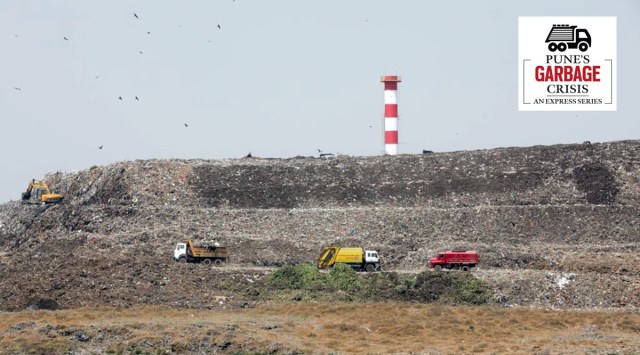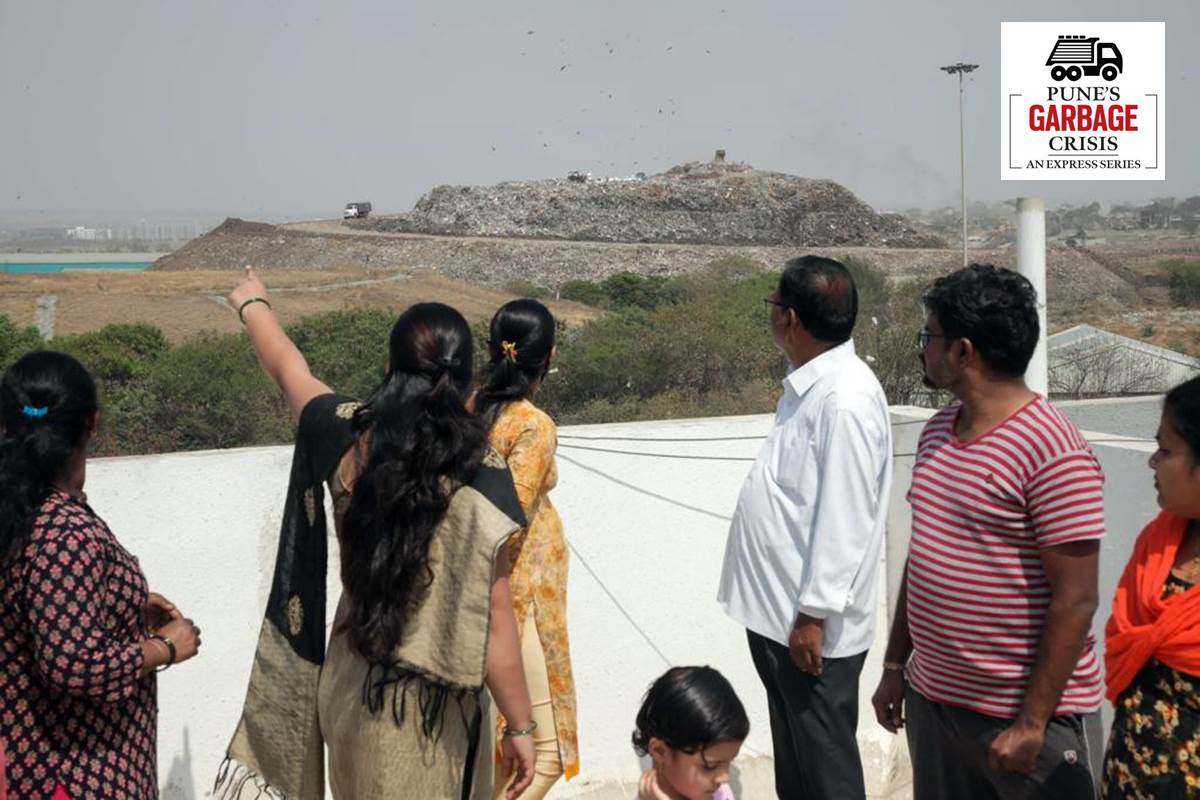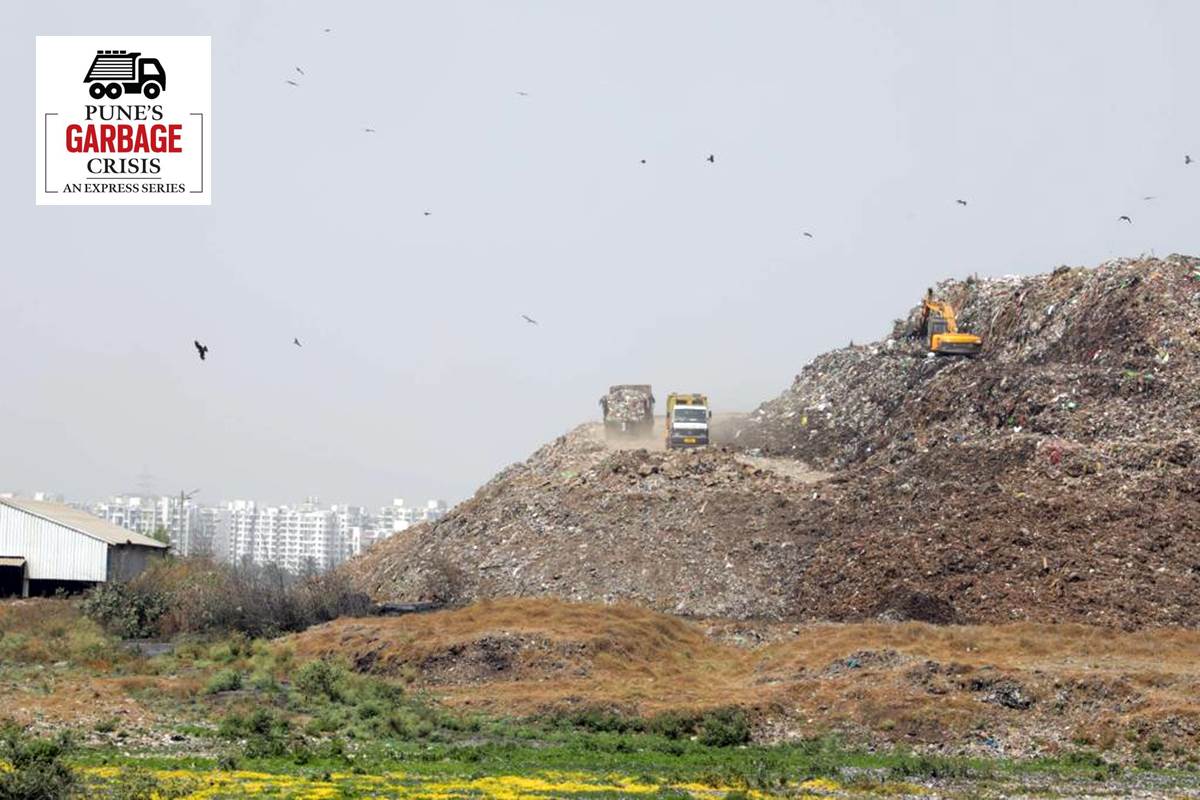A year back, when Priyanka Yadav and her family shifted from Kasarwadi area to the newly developed society of Highland Spaces in Gandharvi Nagari area of Moshi Pradhikaran, they had no inkling of the sights that awaited them. Yadav’s house faced the landfill site of Moshi and in the last one year, a growing mountain of garbage has emerged right outside their balcony.
“Of course, when we booked this flat, we had no idea about this problem. In fact, we were given to understand the landfill site would be a thing of history soon and a safari park was to come up right next to our property,” Yadav said. What has come up instead is the largest garbage dump in Pimpri Chinchwad.

Pimpri Chinchwad generates about 1,100 tons of garbage every day, most of which is carried in trucks to this dump near the Pune-Nashik highway, which is already overflowing. A proposal for a new dump has been pending for over ten years now. The state government is yet to sanction the civic administration’s request.
Story continues below this ad
Part II of the series: Here’s what happens to your garbage once it leaves your home
The garbage being dumped at the 81-acre Moshi field is not meant to remain there permanently. Most of it is supposed to be to put through different processes to derive something useful. Some dry garbage is converted into RDF (refused derived fuel) while segregated wet garbage is turned into compost which is then sold to farmers. A plastic to fuel (oil) plant has been operational for a few years now, while a bio-mining project, meant to convert old garbage into compost, is also functional at the site. A waste-to-energy plant is also supposed to come up. But the amount of garbage that is deposited at the site far exceeds the combined processing capacity of these units.
The result is an ever-increasing hill of garbage that is now visible several kilometers away. Santosh Potghan, a resident of The Address society three kilometres away, says the stench from the open garbage dump in unbearable.
“Most of the times we are forced to keep our doors and windows closed. The stench is too strong to bear,” he said. Potghan said residents of his society rarely invite relatives or friends over to their house. “When we shifted here in January 2020, we had no idea about the magnitude of the problem. We thought the dump was a fair distance away,” he says.
Story continues below this ad
Like many other urban local bodies, Pimpri Chincwhad Municipal Corporation (PCMC) has its own set of woes in management of Municipal Solid Waste (MSW). The corporation uses the landfill site in Moshi to transport garbage from across the length and breadth of its area. Located at a short distance from the Pune-Nashik Highway, this garbage dump was once way outside the city limits. But increased urbanization has seen housing societies mushrooming in and around the dump.
The municipal corporation uses nearly 400 trucks to transport the garbage from across the city to this site. The work of garbage collection and transportation begins at five in the morning, and gets completed only in the afternoon. A major, though less talked about, problem is the spillage of garbage from the mostly open trucks during transportation.
 Pune garbage crisis: Priyanka Yadav, a resident of Highland Spaces in Moshi points to the garbage view from her kitchen balcony. She says she was offered a ‘safari park’ by the builder. Express Photo by Arul Horizon
Pune garbage crisis: Priyanka Yadav, a resident of Highland Spaces in Moshi points to the garbage view from her kitchen balcony. She says she was offered a ‘safari park’ by the builder. Express Photo by Arul Horizon
PCMC’s joint city engineer Sanjay Kulkarni acknowledged that the disposal of garbage was not being done properly, but said most of the problem would be resolved once a new dumping site is made ready.
“As the city expands and more dwellings are added, the load of garbage is bound to go up. It is then not surprising that the collection of garbage exceeds the processing capacity,” he said.
Story continues below this ad
PCMC health chief Dr Anil Roy said the issue was not so much of capacity as the inability to manage the problem in a smart manner. “That is the reason why are focusing on finding smart solutions. And we have been fairly successful in dealing with the waste more effectively in the last one and a half years,” he said.
But the rapidly growing population, the consequent need for housing, office and market spaces, and ever-expanding city limit has been complicating matters. Back in 2015, the state government had reduced the no-development buffer zone around the Moshi dump from 500 meters to 100 meters. This was because of the consistent demand for public representatives some of whom had wanted this to be reduced further. One of the reasons for this was the boom of construction activities. Moshi and its surrounding areas were one of the fastest growing regions of Pune. More than 600 housing societies have come up in the area in the last one decade. And at least half of them are affected by the landfill site.
 Pune garbage crisis: A common refrain among the Highland Space residents is that their relatives and guests refuse to visit due to the waste. Express Photo by Arul Horizon
Pune garbage crisis: A common refrain among the Highland Space residents is that their relatives and guests refuse to visit due to the waste. Express Photo by Arul Horizon
Suraj Poojari, another resident of Highland Spaces, talked about headache and suffocation which this stench causes.
“Our problem increases during the winter and rainy season. People who have asthama have more serious complains than rest,” he said.
Story continues below this ad
A common refrain among the Highland Space residents is that their relatives and guests refuse to visit due to the waste. “The first question they ask is what is this stench- is there a sugar mill nearby,” said Nilesh Gaikwad another resident. This society has more than 360 flats with each and almost everyone has similar complaints.
The garbage dump which had seen the corporation sent crores in setting up a waste to energy plant and a mechanical composter is blamed by many residents of polluting the ground water table. SB Jadhav a resident of Highland Spaces blamed the ever-growing mountain of garbage for the brackish and non-portable state of the water from their borewell.
“We have two borewells, but the water is black and emits a foul odour. All of us have to depend on corporation water and in case it fails, we are forced to get tankers from outside,” he said.
Residents said before they took possession of their tenements, they were told the problem would be solved in the next 2-3 years. But the mountain of waste keeps on increasing with every day before them. Most residents have complained to the corporation and their local representatives but that has not yielded much help.
Story continues below this ad
“All they tell us is that work is in progress,” Jadhav said.
With another civic election right round the corner, some residents feel the only way they can draw attention to their problem is to boycott voting.
Part II of the series: Where does your garbage go from your home?
Writeback: Send in your comments, on this report and others, to pune@expressindia.com



 Pune garbage crisis: Priyanka Yadav, a resident of Highland Spaces in Moshi points to the garbage view from her kitchen balcony. She says she was offered a ‘safari park’ by the builder. Express Photo by Arul Horizon
Pune garbage crisis: Priyanka Yadav, a resident of Highland Spaces in Moshi points to the garbage view from her kitchen balcony. She says she was offered a ‘safari park’ by the builder. Express Photo by Arul Horizon Pune garbage crisis: A common refrain among the Highland Space residents is that their relatives and guests refuse to visit due to the waste. Express Photo by Arul Horizon
Pune garbage crisis: A common refrain among the Highland Space residents is that their relatives and guests refuse to visit due to the waste. Express Photo by Arul Horizon






